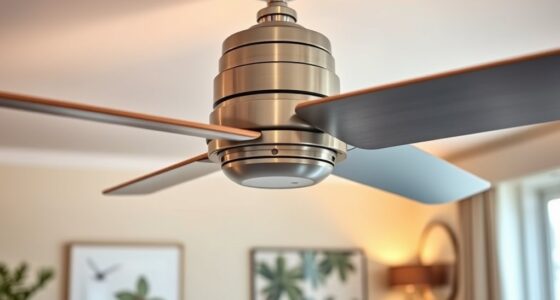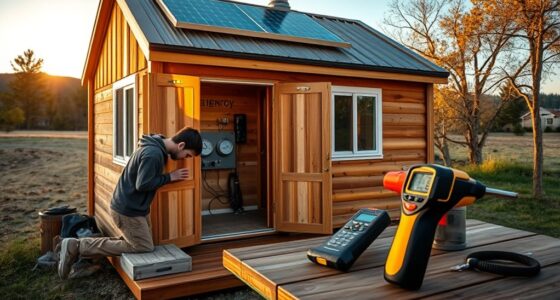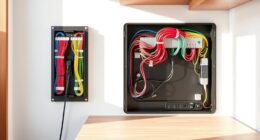Smart plugs are a smart, cost-effective way to save energy and reduce utility bills quickly—often within just a few months. By enabling remote control, scheduling, and real-time energy monitoring, you can cut standby power and optimize device use. Their low power consumption and quick payback make them ideal for homes and businesses looking to achieve fast financial and environmental benefits. If you want to explore how micro-automation can pay off rapidly, keep exploring this topic.
Key Takeaways
- Smart plugs enable remote control and automation, reducing energy waste and lowering utility bills quickly.
- Their low power consumption (1-2 watts) ensures minimal operational costs, leading to fast ROI within months.
- Features like scheduling and auto-off optimize device use, preventing standby power drain and saving energy.
- Energy monitoring provides real-time data to identify savings opportunities and improve efficiency.
- Market growth and technological advances make smart plugs a cost-effective investment with rapid financial returns.
The Rapid Growth of the Smart Plug Market
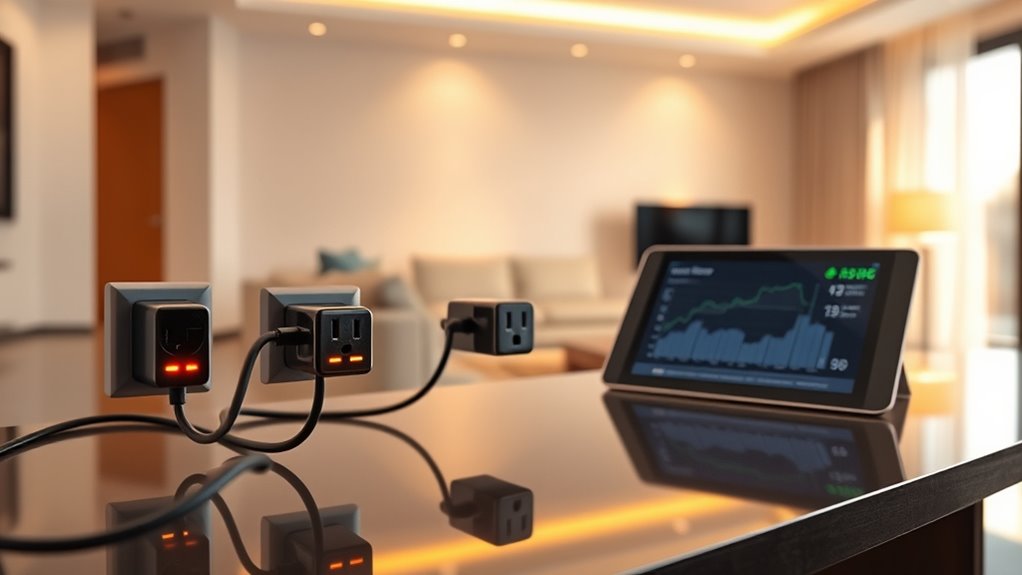
The smart plug market is experiencing rapid growth driven by increasing consumer interest in home automation. In 2024, it’s valued at around USD 3.15 billion and is projected to soar over USD 17 billion by 2032, with a CAGR of 26.4%. By 2034, estimates suggest it could reach USD 30.5 billion, growing at 24.1%. The wired smart plug segment alone is expected to grow from USD 2.5 billion in 2023 to USD 7.6 billion in 2032, at a 13.2% CAGR. North America currently holds over 35% of the market, but Asia Pacific is rapidly expanding, driven by rising smart home adoption. This growth is fueled by consumer demand for connected devices, voice assistant integration, and energy-conscious initiatives, making smart plugs a key part of modern home automation. The industry focus on interoperability and standardization is also accelerating market adoption. Additionally, the push for standardized protocols ensures compatibility across different devices, further boosting consumer confidence and industry growth.
How Smart Plugs Drive Energy Savings and Reduce Costs

Smart plugs play a crucial role in reducing energy consumption by giving you control over connected devices, ensuring they aren’t wasting power when not in use. They consume just 1-2 watts daily, with Zigbee or Z-wave models using even less, around 0.3-0.6 watts. In standby mode, they use about 1 watt, contributing minimally to your energy bill. These devices act as controllers for scheduling, not direct power sources, making them efficient and cost-effective. By preventing standby power drain, smart plugs improve overall household energy efficiency. They enable remote shutdowns, scheduled power-offs, and real-time usage tracking, helping you identify high-energy devices. Smart plugs also support energy monitoring features, allowing you to see detailed consumption data for each connected device. Incorporating power management strategies with smart plugs can further optimize your energy savings. Over time, these small adjustments can notably lower your energy costs, often providing a quick payback period of just a few years.
Environmental Benefits of Micro‑Automation in Homes and Businesses

By automating energy management through micro‑automation devices like smart plugs, homes and businesses can markedly reduce their carbon footprint. These devices cut down on standby power, a significant source of energy waste, helping you use energy more efficiently. As a result, your energy consumption drops, leading to lower greenhouse gas emissions. This supports global efforts to combat climate change and conserve natural resources. Regularly monitoring your energy use through online banking or dedicated apps can further optimize your savings and sustainability efforts bank hours and online services. Here are three key environmental benefits:
- Reduced energy waste and lower carbon emissions
- Conservation of natural resources through decreased electricity demand
- Enhanced sustainability by promoting efficient energy use and smarter consumption habits
Key Features and Technologies Enhancing Smart Plug Functionality

Smart connectivity options like Wi-Fi, Bluetooth, and the Matter protocol make controlling your smart plugs easy and future-proof. Advanced energy monitoring features help you track power usage and improve efficiency. These technologies work together to give you seamless, safe, and convenient control over your household devices. Wireless protocols ensure reliable connections and compatibility with various smart home ecosystems. Recognizing angel number patterns can also enhance your understanding of love opportunities and personal growth through technology.
Smart Connectivity Options
Connectivity options play a crucial role in guaranteeing your smart plug functions reliably and integrates seamlessly with your home automation system. Different protocols offer unique advantages to suit your needs.
- Wi-Fi is the most common, providing direct access to your network for remote control via apps or voice assistants like Alexa or Google Assistant. Its widespread compatibility makes it a popular choice for many users.
- Zigbee and Z-Wave focus on low power use and robust mesh networking, ideal for larger smart home setups that need hubs for operation. These protocols can form a resilient network that extends throughout your home.
- Cellular options like LTE, 5G, GSM, and Sigfox enable control in areas without Wi-Fi, with 5G delivering faster speeds and lower latency for real-time automation. This ensures you stay connected even in remote or mobile situations. Additionally, wireless range & data transfer capabilities are essential for maintaining stable and flexible control tailored to your home environment.
Advanced Energy Monitoring
Advanced energy monitoring transforms how you manage power consumption, offering detailed insights into each connected device. You can track energy use in real time via mobile apps or web interfaces, helping you identify devices that waste power, even in standby mode. Visualizations of data reveal patterns and inefficiencies, empowering smarter decisions to cut bills. Modern plugs utilize protocols like Matter, Thread, Zigbee, and Z-Wave, ensuring secure, low-latency communication across your smart home. Many include historical and predictive analytics, showing your energy trends and suggesting automatic savings. Features like scheduling, auto-off, and remote control further optimize usage. Plus, compact designs with safety protections make monitoring seamless without sacrificing outlet access. Incorporating energy-efficient protocols enhances the reliability and performance of smart plugs in diverse environments.
Practical Applications Across Residential, Commercial, and Industrial Sectors
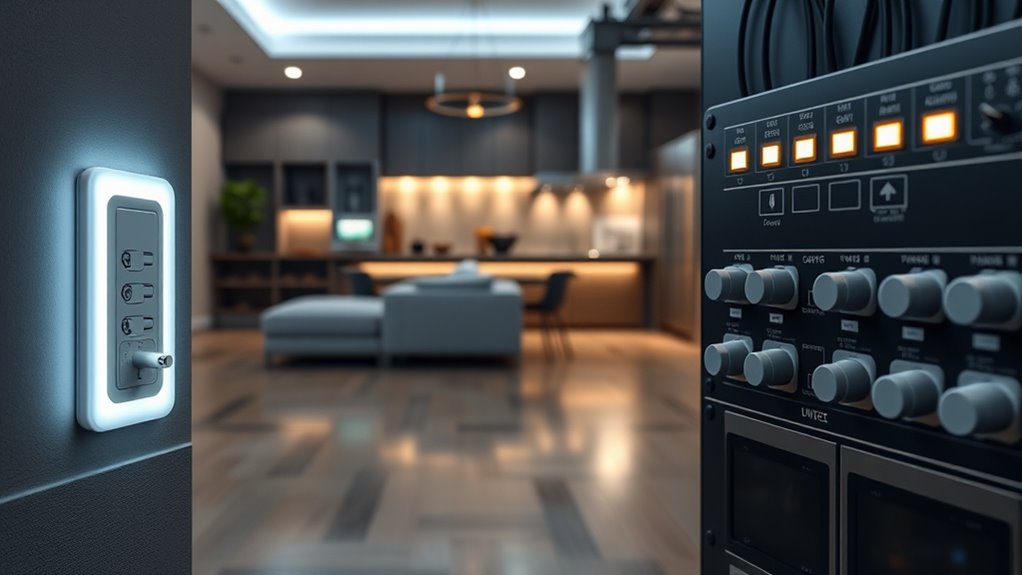
Smart plugs have become versatile tools that improve efficiency and convenience across residential, commercial, and industrial settings. They make managing energy simple and adaptable to your needs. The market for smart plugs is projected to grow significantly, driven by increasing adoption of smart home and energy management solutions. 1. In homes, you can control appliances remotely, automate lighting and HVAC, and boost security by scheduling devices or monitoring status through voice or apps. 2. In commercial spaces, smart plugs optimize energy use across multiple floors, automate environmental controls based on occupancy, and enable remote asset management to reduce maintenance downtime. 3. In industrial environments, they regulate machinery during off-hours, extend equipment lifespan, and integrate with IoT systems for real-time monitoring and automation. These applications help streamline operations, save costs, and support sustainability initiatives across sectors, making smart plugs essential for modern energy management.
Financial Advantages: Achieving Quick Payback Through Smart Plug Usage
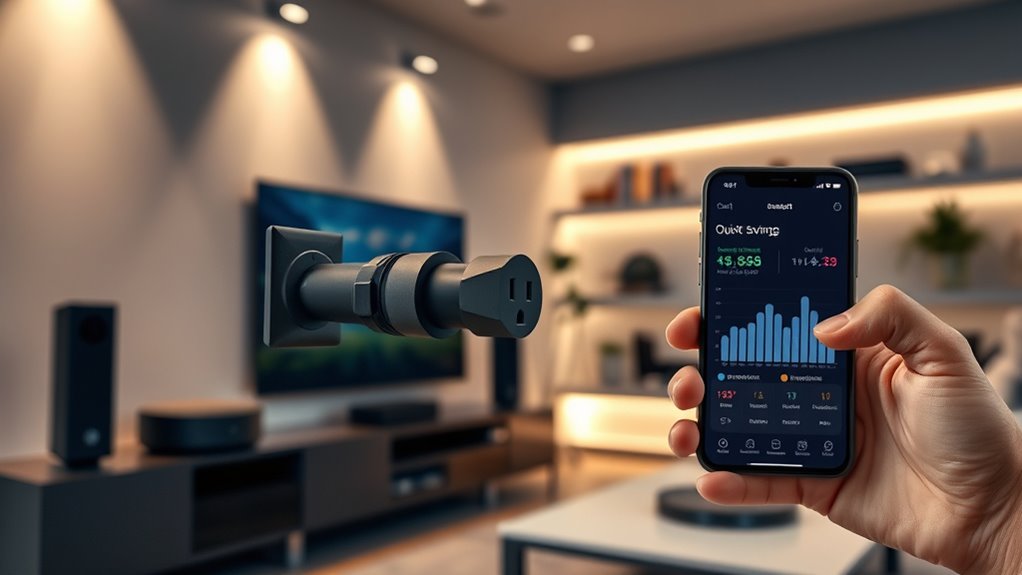
By actively controlling when devices draw power, smart plugs deliver immediate financial benefits through quick payback periods. Their minimal energy consumption—just 1-2 watts daily for Wi-Fi models and even less for Zigbee or Z-wave types—means the cost of running them is negligible. The real savings come from eliminating standby power, which often accounts for over half of energy use in buildings. Smart plugs turn off devices when not in use, drastically reducing phantom loads. Home users report noticeable savings by scheduling devices like entertainment systems overnight. Additionally, real-time energy monitoring and automation help optimize device operation, further lowering costs. Energy monitoring features allow users to see exactly how much energy connected devices consume, helping identify savings opportunities. Understanding energy consumption can empower users to make smarter choices about device usage and maximize savings. With quick payback periods of just months, smart plugs prove to be a cost-effective investment that enhances energy efficiency and reduces utility bills.
Frequently Asked Questions
How Do Smart Plugs Impact Overall Home or Building Automation Systems?
Smart plugs streamline your home automation by connecting to platforms like Alexa or Google Home, allowing you to control devices easily. They enable automation routines that synchronize multiple devices, improving efficiency. With voice commands and remote access, you gain hands-free control. Their energy monitoring features help reduce costs, and by integrating securely, they enhance your system’s reliability, offering a practical, cost-effective way to upgrade your entire home or building automation.
Are There Any Safety Concerns or Regulatory Standards for Smart Plug Installations?
You should know safety concerns and standards for smart plug installations include ensuring they meet certifications like UL, CE, or ETL, which confirm safety and fire resistance. You need to avoid overloading the device beyond its rated capacity and follow proper installation guidelines. Choosing smart plugs with features like overheat protection and regular firmware updates minimizes fire risks and electrical hazards, keeping your home safe and compliant with regulations.
What Are the Privacy Implications of Using Smart Plugs With Iot Connectivity?
Imagine your smart plug as a silent spy, quietly collecting whispers of your daily habits. When you connect these devices, you’re opening a window into your home’s secret life. Your data, including usage patterns, can be shared without your full understanding, exposing your privacy. Vulnerabilities like weak encryption turn your home into an open book for hackers, risking both your safety and personal secrets.
How Do Different Brands of Smart Plugs Compare in Energy Monitoring Accuracy?
When comparing smart plugs’ energy monitoring accuracy, you’ll find that brands like Eve and Shelly excel due to advanced sensors like CSE7766 and Bluetooth/Thread connectivity, offering detailed, reliable data. Wi-Fi plugs like Kasa provide timely updates, while Zigbee and Z-Wave models may lag or flood networks, diminishing accuracy. Always consider protocol, sensor quality, and app responsiveness to guarantee your energy data remains trustworthy and precise.
Can Smart Plugs Be Integrated With Existing Smart Home or Building Management Platforms?
You can definitely integrate smart plugs with your existing smart home or building management platforms. Many smart plugs support popular ecosystems like Apple HomeKit, Alexa, and Google Assistant, often using Wi-Fi, Z-Wave, or Matter protocols. This compatibility lets you control devices remotely, set schedules, and monitor energy usage through your preferred platform. Just make certain the smart plug’s protocols match your system’s requirements for seamless integration and maximum automation.
Conclusion
Embracing smart plugs offers quick, tangible savings and environmental benefits, proving that small changes can make a big difference. With rapid payback periods and versatile applications, you can easily integrate micro-automation into your home or business. Remember, “A penny saved is a penny earned,” so start using smart plugs today to maximize efficiency and reduce costs—because sometimes, the smallest steps lead to the biggest rewards.
I’m Theodore, and I love tiny houses. In fact, I’m the author of Tiny House 43, a book about tiny houses that are also tree houses. I think they’re magical places where imaginations can run wild and adventures are just waiting to happen.
While tree houses are often associated with childhood, they can be the perfect adult retreat. They offer a cozy space to relax and unwind, surrounded by nature. And since they’re typically built on stilts or raised platforms, they offer stunning views that traditional homes simply can’t match.
If you’re looking for a unique and romantic getaway, a tree house tiny house might just be the perfect option.



